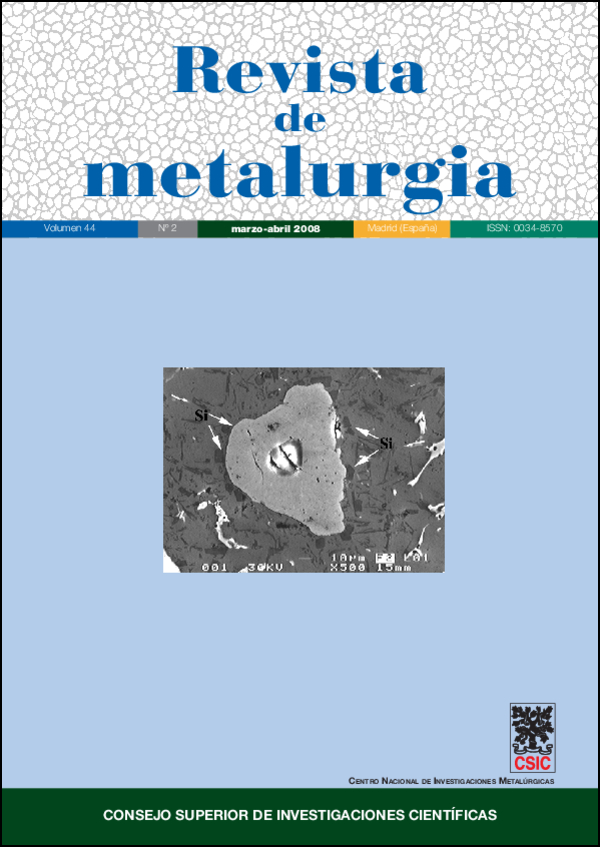Indoor atmospheric corrosion of steel. Its particularities in Cuban tropical climate
DOI:
https://doi.org/10.3989/revmetalm.2008.v44.i2.101Keywords:
Atmospheric corrosion, Indoor, Dust, Pollution, SteelAbstract
Indoor atmospheric corrosion and deterioration of materials is significantly lower respecting outdoors. After 1960, because of the problems detected in electric and electronic equipment and to the requirements for conservation of valuable heritage objects in museums, attention was dedicated to corrosion problems in indoor atmospheres. A small corrosion may cause a bad performance of electric and electronic equipment due to different factors as: change in electrical resistance of contacts, change in conductivity, loss of magnetic properties and others. In the paper corrosion aggressivity of steel inside storehouses and metallic boxes is classified using the new ISO proposal for indoor conditions. Corrosion aggressivity is reported for steel. The levels of aggressivity are reported. They correspond to the higher levels established in the standard proposal. A model for corrosion of steel in function of time of exposure is proposed taking into consideration some atmospheric pollutants. The model has an acceptable fitness to experimental data. It is observed that deposited dust is an important factor in steel corrosion process indoor.
Downloads
References
[1] C. Leygraf Y T.E. Graedel, Electrochemical Society Series, Wiley Intersciences, New York, 2000, pp. 95-97.
[2] C. Leygraf, XV Int. Corrosion Cong., Granada, Ed. CENIM, Madrid, España, 2002.
[3] D. De La Fuente, B. Chico Y M. Morcillo, Rev. Metal. Madrid vol. Extr. (2005) 438-442.
[4] S. Rossi, Int. Sem. Equipment X Weathering, Brasil, Ed. Fundación CPqD, Campinas, SP, Brasil, 2000.
[5] ISO 11844-1:2000, Corrosion of metals and alloys.Classification of low corrosivity of indoor atmospheres. Determination and estimation of indoor corrosivity.
[6] F. Corvo Y J. Rocha-Andrade Da Silva, XV Int. Corrosion Cong. Granada, Ed. CENIM, Madrid, España, 2002.
[7] F. Corvo, N. Betancourt Y A. Mendoza, Corros. Sci. 37 (1995) 1.889-1.901.
[8] M. Ohanian, R. Caraballo, E.A. Dalchiele, G. Gunieo-Cobs, V. Martínez Luaces y E. Quagliata, Rev. Metal. Madrid 41 (2005) 175-185.
[9] F. Corvo, A.D. Torrens, N. Betancourt, J. Pérez Y E. González, Corros.Sci. 49 (2007) 418-435. doi:10.1016/j.corsci.2006.06.002
[10] NC-12-01-09, Método de determinación de la deposición de cloruros en la atmósfera.
[11] ISO 9225:1992, Corrosion of metals and alloys. Corrosivity of atmospheres. Measurement of pollution.
[12] ISO 9223: 1992, Corrosion of metals and alloys. Corrosivity ot atmospheres. Classification.
[13] F. Corvo, J. Minotas, J. Delgado Y C. Arroyave, Corros. Sci. 47 (2005) 883-892. doi:10.1016/j.corsci.2004.06.003
Downloads
Published
How to Cite
Issue
Section
License
Copyright (c) 2008 Consejo Superior de Investigaciones Científicas (CSIC)

This work is licensed under a Creative Commons Attribution 4.0 International License.
© CSIC. Manuscripts published in both the printed and online versions of this Journal are the property of Consejo Superior de Investigaciones Científicas, and quoting this source is a requirement for any partial or full reproduction.
All contents of this electronic edition, except where otherwise noted, are distributed under a “Creative Commons Attribution 4.0 International” (CC BY 4.0) License. You may read the basic information and the legal text of the license. The indication of the CC BY 4.0 License must be expressly stated in this way when necessary.
Self-archiving in repositories, personal webpages or similar, of any version other than the published by the Editor, is not allowed.
















